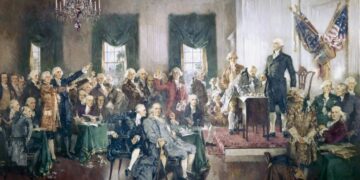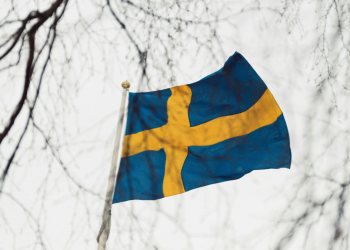One of the first things I did as a new lawyer was to search for a frameable print of Howard Chandler Christy’s painting of the signing of the Constitution on September 17, 1787. Having just spent three years in law school studying that document and our jurisprudence flowing therefrom, I hoped to keep in mind its principles and the freedom they have provided for America and the world. What better way to do so, I thought, than to gaze every day on Christy’s magnificent portrait. The original hangs in the Capitol, whose website describes the lengths to which the artist went in order to depict the event as authentically as possible.
Howard Chandler Christy’s painting of the signing of the United States Constitution was commissioned in 1939 as part of the congressional observance of the Constitution’s sesquicentennial. Completed in 1940, the 20-by-30-foot framed oil-on-canvas scene is among the best known images in the United States Capitol. It is on display in the east grand stairway of the House wing.
The painting depicts Independence Hall in Philadelphia on September 17, 1787. George Washington is the most prominent figure; he stands on the platform next to Richard Spaight of North Carolina, who is signing the document. Eighty-one-year-old Benjamin Franklin is seated in the center, with Alexander Hamilton leaning toward him, while James Madison appears farther to the right. In comparison to many of the historical paintings in the Capitol, the colors are bright and airy, and the brushwork is almost impressionistic in places. Christy used light and shadow to unify the individual portraits.
To achieve the greatest possible accuracy, Christy searched for portraits by the best artists of the late 18th and early 19th centuries, such as Charles Willson Peale and Gilbert Stuart. He located portraits of 37 out of the 39 delegates and the Secretary, William Jackson. Christy took some liberties in composing his scene: John Dickinson, whose signature was added by proxy, is included, and three men who were present but did not sign are not shown. He obscured the faces of the two signers (Thomas FitzSimons and Jacob Broom) of whom no portraits were found. He also researched authentic costumes, including a pair of George Washington’s breeches borrowed from the Smithsonian Institution, and he depicted the furniture and artifacts used by the delegates.
The books beside Franklin’s chair were part of Thomas Jefferson’s library; Christy borrowed them from the Rare Book Room of the Library of Congress and included them in the scene to acknowledge Jefferson’s importance to the Constitution. He made the sketch for the painting in Independence Hall in September, at the same time of day as the signing, to show accurately the angle of sunlight in the room with its glass chandelier. The artist said that the flags he depicted are the Stars and Stripes, one from a Maryland dragoon regiment, and regimental colors from Massachusetts and New Hampshire….
After five years of research and seven months of painting, the canvas was dedicated in May 1940 in the Rotunda of the Capitol, where it was on view for 16 months… After much debate about where it could be hung, another painting was moved and the Christy in its frame was installed in the east grand stairway of the House, where it remains today.
Seeing even a print of the painting is inspiring, but viewing it in person in all of its 600 square feet of colorful radiance is breathtaking. You feel drawn back to that unique moment in history when the Founders affixed their names to what British Prime Minister William Gladstone called “the most wonderful work ever struck off at a given time by the brain and purpose of man.”
And for all their brainpower and purpose, the delegates also fervently acknowledged a higher power that attended their efforts. William Samuel Johnson spoke of the “signal intervention of divine providence,” while Charles Pinckney admitted to being “struck with amazement” at the same “super-intending hand of Providence, that so miraculously carried us through the war.” James Madison, rightly called the Father of the Constitution, declared, “It is impossible for the man of pious reflection not to perceive in it a finger of that Almighty hand which has been so frequently and signally extended to our relief in the critical stages of the revolution,” and “impossible to consider the degree of concord which ultimately prevailed as less than a miracle.” The same word was used by George Washington who, after presiding over the Convention, called the outcome “little short of a miracle.”
The impact of that miracle is beyond calculation, says Matthew Spalding,
The creation of the United States Constitution—John Adams described the Constitutional Convention as ‘the greatest single effort of national deliberation that the world has ever seen’—was one of the greatest events in the history of human liberty. The result of the convention’s work has been the most enduring, successful, enviable, and imitated constitution man has ever known.
Why? Because, as Spalding explains, the Constitution is grounded in “permanent truths about man, politics, and liberty,” those truths articulated in the Declaration of Independence—to which the Constitution ties itself. Kevin “Seamus” Hasson points out that the Constitution does not claim to “grant the blessings of liberty,” but rather to secure them, thereby referring back to the the Declaration of Independence.
America has chosen—from the Declaration on—to accept the premise that it is “self-evident” that we are “all…created equal” and “endowed by [our] Creator with certain inalienable rights.” The Declaration further teaches that the proper role of government is to “secure” the people’s rights. Not to “bestow” or “grant” those rights, but to “secure” them. The rights already exist. We need the government only to respect our rights in the way it treats us, and to guard our rights against infringement by others. The preamble to the Constitution uses the same verb, secure, in order to acknowledge that point.
This is the heritage I wanted to be reminded of in my law practice by Christy’s masterpiece. But alas, my efforts to find a print were in vain, and it seemed I was out of luck. One last possibility finally occurred to me. Perhaps I could hire a photographer in Washington to go and actually take a picture of the original. I did so and received a stunning 20×30 inch photo, which I mounted in a worthy frame. The picture has hung on my wall ever since and been an unending source of inspiration.
Over the decades, however, something unexpected has happened. The photo has gradually faded and the colors have become subdued, looking more and more like it has somehow been intentionally antiqued. Meanwhile, something unexpected has also happened with the Constitution whose signing the picture portrays. Not unlike what happens in the story of Oscar Wilde’s The Picture of Dorian Gray, the Constitution itself seems to be fading right along with the picture, and fading fast.
The Founders themselves had warned that there were conditions to keeping it bright, beginning with what Benjamin Franklin told Mrs. Elizabeth Willing Powel at the conclusion of the Convention. “Well Doctor,” she asked Franklin, “what have we got, a republic or a monarchy? A republic, replied the Doctor, if you can keep it.” And the Founders could not have been clearer on how to keep it. “Our constitution was made only for a moral and religious people,” said John Adams. “It is wholly inadequate to the government of any other.” President George Washington said the same in his Farewell Address: “Of all the dispositions and habits which lead to political prosperity, Religion and morality are indispensable supports.”
No wonder America is fading. But it is also under attack. If the recent 20th anniversary of 9/11 has reminded us that terrorists cannot destroy America, Constitution Day on 9/17 reminds us that America can be intentionally destroyed from within. And it is happening. Americans who hate America are, says Mark Levin, “using America’s freedom to destroy freedom and the Constitution to destroy the Constitution” in a multi-faceted Marxist movement that is sweeping the nation.
The counterrevolution to the American Revolution is in full force. And it can no longer be dismissed or ignored, for it is devouring our society and culture, swirling around our everyday lives, and ubiquitous in our politics, schools, media, and entertainment. Once a mostly unrelatable, fringe, and subterranean movement, it is here—it is everywhere. You, your children, and your grandchildren are now immersed in it, and it threatens to destroy the greatest nation ever established, along with your freedom, family, and security.
This counterrevolution and its “cancel culture” target the very thing that has made America into the greatest nation on earth: our Founding principles as memorialized in the Constitution and the Declaration of Independence. Now as never before, if America is to survive, those who love the liberty endowed by our Creator must step up and defend it, as Spalding urges.
We must look to the principles of the American Founding not as a matter of historical curiosity, but as a source of assurance and direction for our times. In a world of moral confusion, and of arbitrary and unlimited government, the American Founding is our best access to permanent truths and our best ground from which to launch a radical questioning of the whole foundation of the progressive project.
Besides the inspired truths memorialized in our inspired Founding documents, the Founders also bequeathed to us an inspiring example of courage in defending those truths. “We must rise to the challenge, as did our Founding Fathers,” says Levin, “when they confronted the most powerful force on earth, the British Empire, and defeated it.” And we must, he urges, act in concert and without delay.
We must seize every opportunity to take back our institutions by running for office, seeking appointed office, and populating professions—including academia, journalism, and business—with patriots who can make a difference. We must take it upon ourselves to teach our children and grandchildren about the magnificence of our country, constitution, and capitalism, and the evils of Marxism and the people and organizations that promote it…. The time to act is now. Each of us must take time out of our daily lives to help save our country. We must be tactical and nimble in our responses to American Marxism and its multiple movements. And we must organize, rally, boycott, protest, speak, write, and more…. Patriots of America, unite!




















Discussion about this post